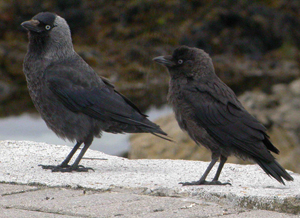Between the well-kept flowerbeds and over neatly-trimmed lawns, nesting garden birds flit to and fro, their endeavours to rear their young a shining example of what hard-working, faithful couples can achieve. Or so, until relatively recently, it was presumed ...
Garden bird enthusiasts might be surprised – shocked even – to discover the goings on in their own back gardens that recent developments in technology have revealed.
Developments in molecular biology have now shown that in passerines – the songbirds – true genetic monogamy occurs in only around 15% of species. Indeed, many of those birds that ‘play the field’ regularly inhabit our back gardens.

If you're looking for an example of monogamy – or, at least, a pretty close approximation – you should look no further than the Jackdaw. Despite their sociable breeding habits, pairs often mate for life and only 1% of chicks are reared by a male that is not their genetic parent.
However, the picture elsewhere is quite different!
Some 40% of Blue Tit nests contain at least one chick that is reared by a male that is not its genetic parent, whereas in Great Tits this figure is over 30%. The diminutive Coal Tit is even more dissolute, with more than a quarter of the chicks not related genetically to the provisioning male and 75% of nests containing at least one ‘extra-pair’ nestling.
Research shows that female House Sparrows can be attracted to several males in a neighbourhood, with 20% of nests containing one or more chicks that are unrelated to the provisioning male. In Starlings, this figure rises to over 30% while in more occasional garden visitors, Yellowhammers and Reed Buntings, it grows to nearly 70% and nearly 90% of nests, respectively.
The furtive rustlings extend to two of our most graceful summer visitors – Swallows and House Martins. Nearly 30% of nestlings reared by a male Swallow will not, on average, be his own and in the House Martin, this figure approaches 20%. Interestingly, the tail length of male Swallows is all-important – the longer the tail, the more likely it is that he will sire young in more than one nest.
Why find extra mates?
So, monogamy is the exception, rather than the rule in passerines. Why is this?
There are several benefits to female birds of mating with different males. It can increase the genetic diversity of their brood, which might make these youngsters less susceptible to succumbing to disease. For a female that is paired with a low-quality male, mating with a higher-quality bird might also improve the survival prospects of her young.
Alternative explanations have also been posited. For instance, by mating with another male, a female might increase her chances of pairing with this bird should her actual mate perish or leave. Alternatively, the female might enjoy feeding opportunities on the territory of her extra-pair mate or gain another body to defend her nest.
There are also potential costs, however. If males adjust their provisioning efforts relative to their certainty of paternity, female infidelity might result in something of a lay-about father. It can also take time and energy to assess lots of different males, particularly if they are widely dispersed. Moreover, as in other animals, swapping partners increases the chances of acquiring sexually transmitted diseases.
- You can read more about ‘extra-pair paternity’ in birds in the open-access review article Extra pair paternity in birds: a review of interspecific variation and adaptive function.